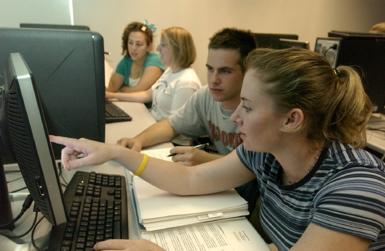Biostatistics: This hot field is attracting undergraduates
Students from many disciplines explore the field in an intensive summer course

Biostatisticians — analysts of biological data — are charged with finding answers to some of the world’s most pressing health questions: how safe or effective are drugs hitting the market today? What causes autism? What are the risk factors for cardiovascular disease? Are those risk factors different for men and women or different ethnic groups?
The science answering these and many other questions is being done in a variety of industries, leading to a growing need for biostatisticians. But recently, the national economy has squeezed some of those industries and many government-funded positions — fueling competition. In a field where any kind of statistical training was once an advantage, a master’s degree in biostatistics is increasingly called for in entry-level positions.
To help students determine if biostatistics is the right career for them, Boston University created an intensive six-week undergraduate program with a grant from the National Heart, Lung and Blood Institute (NHLBI).
The growing demand for skills, and the subsequent growing competition among biostatisticians, has fueled the success of the course, which is designed to expose undergraduates to the specialized yet versatile field and encourage them to consider it as a career. The program attracts top students from schools across the country.
“These are 4.0-type students,” says Lisa Sullivan, an associate professor of biostatistics and associate dean for undergraduate education at the School of Public Health.
Of the more than 100 students who applied this year, 24 were chosen, with a few from Boston University. They are math, biology, psychology, and sociology majors, premed students, and future statisticians and teachers. Whether they plan to go on to teach, do research, practice medicine, or develop drugs, students say they will use the skills they learned in biostatistics directly or indirectly in their ultimate professions.
Guest lecturers in this year’s summer course included doctors running clinical trials, CEOs of professional biostatistics analysis firms, and researchers from the Framingham Heart Study, the NHLBI’s landmark epidemiological study begun in 1948 and run by BU since 1971.
Joe Butash, a premed biology and philosophy major at the University of Scranton, says that until he took the class, he never realized how influential biostatistics is in the daily lives of doctors and nurses. Aesha Dharia is a psychology major with a minor in statistics and plans to attend medical school. She prefers the clinical setting to the research lab.
“It has more human and interactive elements,” she says, but increasingly it calls for analytic skills of biostatistics. “You could do pretty much anything. It depends on what angle you take.”
Where the jobs are
Biostatistics can be applied to fields from hospital systems to genomic analysis. Wherever there are government regulations, there are statisticians. Hence, the highly regulated pharmaceutical industry is one of the largest employers of biostatisticians.
Since so much research is federally funded, the national debt and the war in Iraq have cut into the growth of the field, says Dr. Robert Newcomb, director of the Center for Statistical Consulting at the University of California Irvine.
“I think there is change, and I think it’s in the contraction direction,” Newcomb said of the current job market.
Katherine L. Monti, senior statistical scientist for Rho, Inc., in Newton, a company that handles clinical trials for pharmaceutical companies, has found that her degree in biostatistics has enabled her to work a wide variety of projects in many industries since she completed her Ph.D. in 1975.
“I expected to go into academia and stay there,” she says, but over her career she has analyzed a range of products from the emulsifier in Twinkies to dog food to new medicines. She has lived all over the United States and continues to get calls from recruiters. And over time, statisticians’ contributions to scientific endeavors have been recognized. “They [biostatisticians] are becoming increasingly accepted in the scientific community,” Monti says.
Barbara Day, a senior recruiter for the recruiting firm Smith Hanley, has been placing biostatisticians in pharmaceutical company jobs for eight years. Biostatisticians are in demand at pharmaceutical companies for preclinical, clinical and nonclinical trials. She sees a down-cycle in the market at the moment, but doesn’t expect it will last. Graduates with exceptional communication skills are needed as consultants to work directly with other scientists, helping them translate their data into useful, understandable information.
While general statistical training might have been enough for such jobs a few years ago, the market is becoming tighter, Day says.
“The entry-level market has really kind of turned to the Ph.D.s,” she says.
A master’s-level biostatistician in the pharmaceutical industry today might be able to work in quality control designing experiments or in marketing, Day says. A master’s could also lead to research work in medical and cancer centers, teaching jobs, and government positions.
Get a degree – stat
Boston University offers an M.S. and Ph.D. in biostatistics jointly through the College of Arts and Sciences math department and the School of Public Health. The program has been growing steadily: in the fall of 2000, 31 students were enrolled in those programs. As of fall 2004, 58 students had enrolled, seven as Ph.D. candidates, according to Anita DeStefano, an SPH associate professor of biostatistics and neurology. This fall, there was a 32 percent increase in the number of applicants, she says, making the admission process more competitive.
“We are able to be more selective, and the students entering the program in recent years have been very highly qualified,” DeStefano says.
While there are many opportunities to apply biostatistics skills, there are few programs that focus on it, says Natalie Nelsen, a math and computer science major from Doane College in Crete, Neb. She took BU’s class this summer before attending graduate school in biostatistics at the University of Nebraska this fall.
“There is so much you can do with [biostatistics],” Nelsen says. “And it makes a difference.”